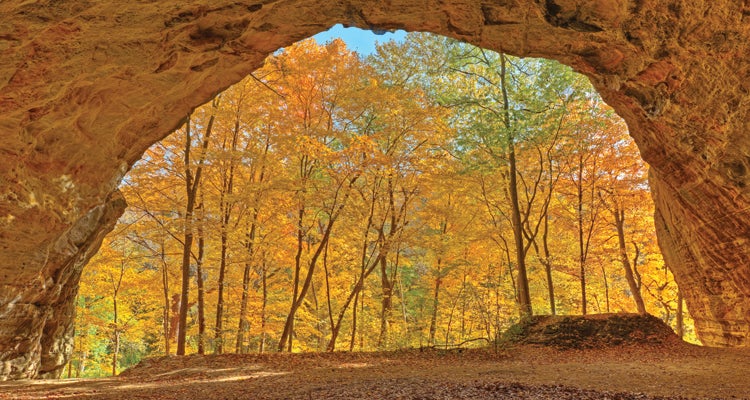Three Amazing Foliage Hikes To Do in a Day

'Duck into the Council Overhang, a cavernous amphitheater, near mile 4 on the Illinois Canyon Trail. Photo by: Jim Vallee'
Illinois Canyon Trail, Starved Rock State Park, Illinois
Climb atop Lover’s Leap Overlook and you’ll wonder who set the Illinois River Valley on fire. Each fall, birches, poplars, and hickories erupt into waves of gold, punctuated by the reds of silver maples and white oaks. Get there via a 9.4-mile out-and-back on the Illinois Canyon Trail, which winds past the mouths of 18 sandstone canyons (budget time to explore) and through a corridor of evergreens and colorful oaks. From the parking area, head .3 mile north to Starved Rock, a 125-foot-high sandstone butte, then follow the trail .4 mile to reach the Lover’s Leap Overlook above the Illinois River. From here, proceed .1 mile to the Eagle Cliff Overlook for more foliage views. Continue 3.9 miles down to Illinois Canyon in the leafy corridor, then retrace your steps to the trailhead. Beware the poison ivy (which also turns red this time of year). Typical foliage Third week of September through end of October Contact bit.do/StarvedRockSP
Mt. Cardigan, Cardigan Mountain State Park & Forest, New Hampshire
Sure, you can see brilliant fall colors all over New England through a windshield. But why leaf peep when you can leaf gape? From Mt. Cardigan’s bald, 3,136-foot summit, get a 360-degree panorama of the northern Appalachians enveloped with yellow, orange, and red sugar maples, golden-bronze American beeches, and yellow birches. From the AMC Cardigan Lodge, link the Manning, Holt, Cathedral Forest/Holt-Clark Cutoff, and Clark Trails to summit Cardigan on a 5-mile out-and-back. At the top, scan for color north to the White Mountains, northwest to the Green Mountains, and south to the Ragged Mountains. Either retrace your steps or add a second summit by looping .6 mile north on Mowglis Trail to 3,064-foot Firescrew (then take the Manning Trail 1.8 miles back to the trailhead). Typical foliage Third week of September through third week of October Contact nhstateparks.org
Granite Mountain, Mt. Baker- Snoqualmie National Forest, Washington
Hike up, up, and away on this 8-mile out-and-back that climbs 3,800 feet to the top of 5,610-foot Granite Mountain. The reward for nearly a thousand vertical feet per mile? Wide vistas of the Cascades wearing golden yellow (and a lookout tower from which to view it all). From the Pratt Lake trailhead, take the Pratt Lake Trail 1.2 miles to the Granite Mountain Trail, then proceed northeast along the huckleberry-lined path (bright red this time of year; fruiting in September). From the rocky summit, see Rainier to the south and 6,259-foot Kaleetan and 10,420-foot Baker to the north—but you’re here for more than mountain views. Check out the hillsides for streaks of yellow larches and the valley floor for red huckleberry bushes. Return the way you came. Typical foliage Third week of September through third week of October Contact fs.usda.gov/mbs